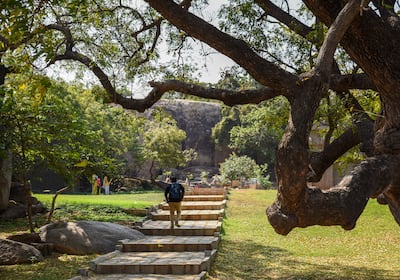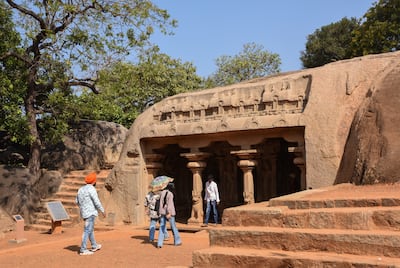Shaded by a 1,300-year-old Hindu temple, I peered into the Indian Ocean imagining the fury unleashed here in Tamil Nadu by the 2004 Boxing Day tsunami. For all their destruction, those waves left behind one extraordinary, puzzling gift.
Excited archaeologists soon swarmed this coastal town of Mahabalipuram, 50km south of Chennai. They studied ancient structures in the ocean sand revealed by the tsunami, hoping these remains may be part of the legendary underwater temples of the 1,200-year-old Pallava dynasty.
The puzzle of those subsea temples remains unsolved. But one sits above the ocean, and the Unesco World Heritage site and tourist attraction recently became India's first “green energy archaeological site”.
Late last year, Indian authorities revealed the temple is fully powered by solar energy. Known as Mahabalipuram Shore Temple, it is the very same building that shielded me from the fierce Tamil Nadu sun as I stared seaward.

An array of green technology was installed at this site during a joint project by NGO Hand in Hand India and the Renault Nissan Technology and Business Centre India. Three solar energy plants now power this site, including its reverse osmosis facility. Due to that facility, tourists visiting this magnificent temple, which is surrounded by lawns and abutting the beach, can now get free drinking water from three separate kiosks.
Travellers can easily access Mahabalipuram from Chennai. Etihad Airways, Indigo and Air Arabia all have direct flights from Abu Dhabi to the capital of Tamil Nadu, which has a population of more than 10 million. From downtown Chennai, it took me 90 minutes by taxi to reach Mahabalipuram.
Follow my lead and pause along the way at another seaside attraction, Krishanankaranai. It has a cluster of temples and monuments dating back more than 1,000 years, which were also revealed by the tsunami. I was awed by the size and ancient Tamil inscriptions of the Tsunami Stone, a colossal slab tossed by the waves and now stands tall in Krishanankaranai.
Some of these sites may be linked to Shore Temple and the similarly mysterious Pallava kingdom. This dynasty commanded a swathe of southern India, between the fourth and ninth centuries, although its origins remain hotly debated. What is beyond dispute is the grandeur of the many marvels it built at Mahabalipuram.
Uncovering treasures of the Pallava kingdom

Before visiting Shore Temple, I ventured a short distance inland to the sprawling remains of a former Pallava settlement. Although this kingdom was ruled from Kancheepuram, about 50km to the east, the Pallavas developed Mahabalipuram into a prosperous seaport.
I was impressed by the skilful craftsmanship and obvious manpower represented by the many monuments carved into, or out of, rock more than a millennia ago. Olakkannesvara Temple sits high on an outcrop. From its lofty perch, I looked down on almost a dozen more attractive stone temples, including Krishna Mandapam and Adivaraha, Mahishasura Mardini and Varaha caves.
Each was overshadowed, however, by the wondrous Arjuna’s Penance. This towering rock face, about 13 metres tall and 29 metres wide, is embellished by more than 100 bas-reliefs depicting animals, warriors and deities. Fascinated to learn more about the artistic splendour of Mahabalipuram, I bought a book on its history from a vendor outside Arjuna’s Penance.
It explained that the rulers of Pallava were passionate patrons of the arts. In particular, they were enamoured with the rock-cut glory of the Ajanta Caves in the Indian state of Maharashtra, where more than a dozen spectacular Buddhist structures are carved into cliffs.

Mahabalipuram may not be nearly as famous as Ajanta, either within India or abroad, but its rock monuments are among the most dazzling historical sites I’ve witnessed across many visits to this giant nation. And the mystery of the Shore Temple, and the Pallava’s seven underwater shrines, only heightens the allure of Mahabalipuram.
I was free to wander around and inside Shore Temple, a granite structure made up of two sanctums. At its core is a multi-tiered tower, intended to resemble a pyramid, which is in fine condition considering its age and the ravages of the adjacent ocean.
It was constructed by Pallavan king Rajasimha and is one of southern India’s oldest religious structures. All around me, visitors queued to pose for photos in front of this marvel. Shore Temple is so distinctive that it even caught the gaze of Marco Polo. The legendary Italian explorer visited Mahabalipuram in the late 13th century and wrote accounts of this lively port. He also contributed to an ongoing mystery by describing what he called seven tremendous “pagodas” on the seafront.
More than 700 years later, scientists are still trying to locate the other six structures that complete this set, alongside Shore Temple. They’re widely believed to have been consumed by the ocean. Perhaps one day the sea will reveal them once more. Until then, Shore Temple is emerging as a unique tourist attraction not just thanks to this intrigue, and the brilliance of its architecture, but its new clean and green makeover.

